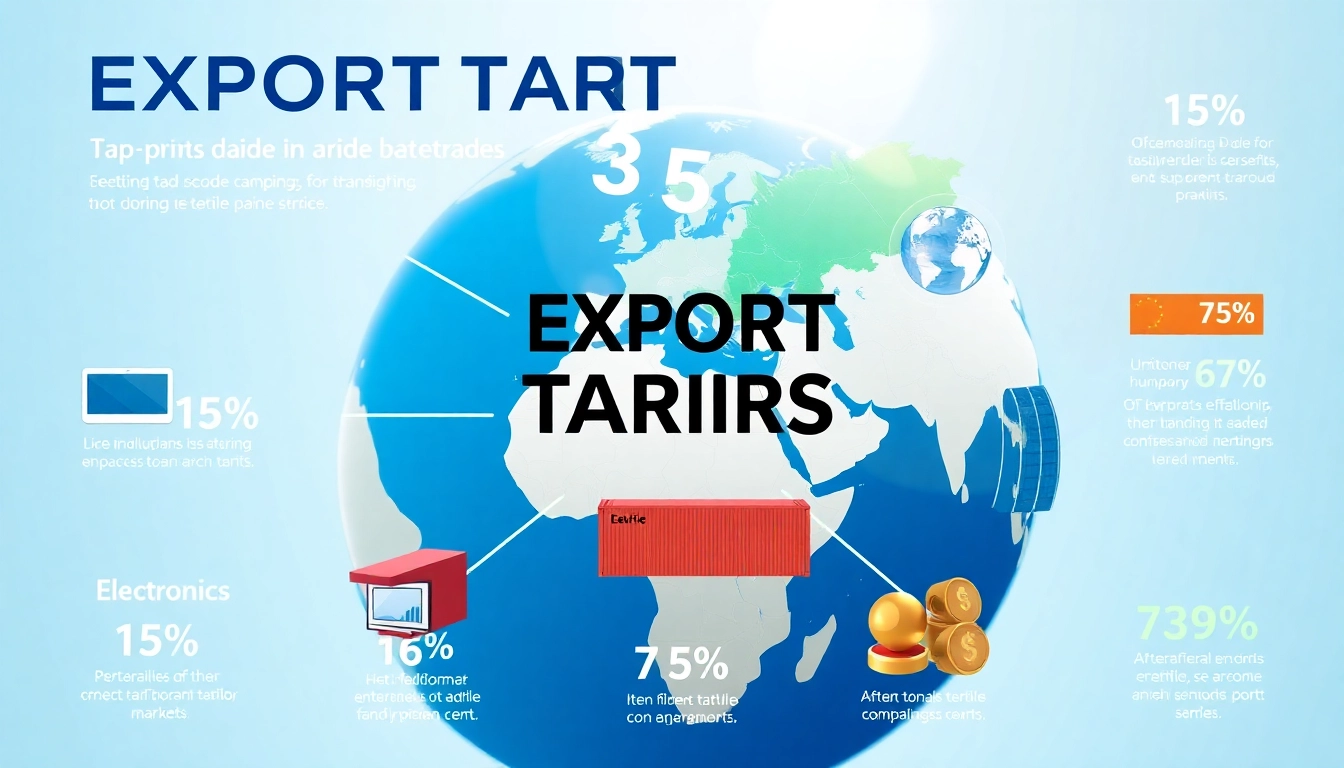What Are Export Tariffs?
Definition and Overview
Export tariffs, often referred to as export duties, represent a fee imposed by a government on the sale of goods being shipped out of the country. Unlike the more commonly discussed import tariffs, which are charged on goods brought into the country, export tariffs can influence the flow of goods from one nation to another. An export tax may be levied on commodities or raw materials and is ultimately borne by the exporter. These tariffs can play a significant role in a nation’s trade policy, affecting both domestic producers and international relations.
Typically, export tariffs are implemented to raise government revenue, protect domestic industries against foreign competition, or to exert influence over trade negotiations. While most developed countries impose minimal to no export taxes, certain states, particularly those rich in natural resources, may impose significant levies to control the supply of their resources on the world market.
Historical Context of Export Tariffs
The history of export tariffs is deeply intertwined with the evolution of trade and economic policy globally. During the colonial era, many European nations implemented high export duties to maximally profit from their colonies’ raw materials, which were shipped abroad for manufacturing. As economies have evolved, so have the policies that govern trade.
In the late 19th and early 20th centuries, countries began reassessing the need for export tariffs, recognizing the complexities they introduced into global trade dynamics. The goal shifted towards fostering international trade liberalization, reflected in agreements intended to reduce barriers to trade.
Despite this shift, export tariffs have seen a resurgence in the modern era, particularly in scenarios involving resource-rich countries seeking to elevate the domestic price of natural commodities or to stabilize local markets. Current debates in trade policy often reference the balance of free trade against economic nationalism, where export tariffs could serve as tools of protectionism or negotiation.
Types of Export Tariffs
Export tariffs can be categorized into several types based on their application and purpose:
- Specific Tariffs: A fixed fee imposed on a quantity of goods exported, such as a flat rate applied to every ton of steel shipped overseas.
- Ad Valorem Tariffs: A percentage of the value of the goods exported, which can fluctuate based on the market value of the product being exported.
- Prohibitive Tariffs: Extremely high tariffs meant to severely limit, if not entirely eliminate, certain exports from leaving the country.
- Export Quotas: While not a tariff per se, these restrictions limit the quantity of goods that can be exported within a specific time frame, effectively regulating supply and demand.
The Economic Impact of Export Tariffs
Effects on Domestic Producers
Export tariffs can have significant repercussions for domestic producers, both positive and negative. On one hand, by imposing duties on exports, governments may aim to keep essential goods within the local market, fostering lower domestic prices. However, the side effects are complex:
- Revenue Generation: Export duties can significantly contribute to government revenues, which can be redirected into domestic programs.
- Competitive Disadvantage: Increased costs of exporting can make domestic products less competitive on a global scale, leading to a decline in international sales.
- Indirect Effects: Producers relying on imported intermediate goods for production may face increased costs, passing these financial burdens onto consumers and reducing overall demand.
Influence on International Relations
Export tariffs can serve as tools for foreign policy. Nations may apply tariffs strategically in response to international trade disputes. For instance, higher export tariffs or restrictions can strain bilateral relationships, leading to retaliatory measures and ultimately a breakdown in trade agreements.
On the flip side, nations might use favorable export tariff rates to strengthen alliances or encourage trade with certain countries. This maneuvering illustrates the necessity for countries to carefully weigh their tariff policies against their broader diplomatic and trade objectives.
Consumer Price Adjustments Due to Tariffs
While export tariffs are often viewed through the lens of producer impact, it’s crucial to examine their effects on consumer prices. When exporters face additional fees, they often pass these costs onto consumers, resulting in higher prices for goods in the domestic market. This can lead to inflationary pressures, particularly in industries reliant on exported materials or goods.
Moreover, as domestic production becomes constrained due to export restrictions, scarcity can drive prices up further, exacerbating economic disparities. Thus, consumers may bear the brunt of export tariff policies, which can challenge economic growth by limiting purchasing power across the population.
How to Calculate Export Tariffs
Factors Influencing Tariff Rates
Various elements can influence the calculation of export tariffs, including the type of goods being exported, their market value, governmental trade policies, and international agreements. Significantly, the nature of the product—whether it’s a raw material, agricultural good, or manufactured product—can affect the rate applied.
Other factors include:
- Commodity Global Prices: Fluctuating prices can lead to adjustments in tariff rates to either encourage or limit the export of certain goods.
- Domestic Economic Conditions: Changes in the domestic economy, such as recessions or booms, can also lead to tariff modifications as governments respond to market needs.
- International Trade Obligations: Membership in organizations like the WTO can impose restrictions or guidelines on tariff rates.
Methodologies for Calculation
Calculating export tariffs usually involves determining the appropriate rate based on the product’s value and applying either specific or ad valorem tariffs. The process can be summarized in a few key steps:
- Determine the Valuation: Assess the export commodity’s market value at the time of shipment.
- Identify the Applicable Rate: Consult governmental regulations or trade agreements to identify the specific export tariff rate.
- Calculate the Tariff: Multiply the commodity’s value by the applicable tariff rate to ascertain the total export duty due.
Examples of Export Tariff Calculation
To illustrate, let’s consider an example of how export tariffs are calculated:
Suppose a company wishes to export 100,000 kilograms of steel valued at $1,000,000. If the government charges a 10% export tariff on steel, the calculation would be:
Export Tariff = Value of Export × Tariff Rate = $1,000,000 × 10% = $100,000
Thus, the company would need to pay $100,000 in export tariffs before shipping their steel abroad, illustrating the significant cost implications of such duties.
Countries and Their Export Tariff Regulations
Comparative Analysis of Global Tariff Policies
The approach to export tariffs varies significantly around the globe. For instance, many developed nations maintain relatively low or nonexistent export tariffs to maintain competitive advantages in international trade, facilitating easy exportation of goods.
On the other hand, countries like Argentina and Bolivia impose higher export tariffs on agricultural and oil products, respectively, intending to stabilize domestic markets or garner more revenue. Such differing policies can foster trade tensions and negotiations between nations as they navigate their tariff structures.
Legal Framework Governing Export Tariffs
In the United States, Article 1, Section 9 of the Constitution prohibits the imposition of export taxes, making the landscape for export tariffs distinctive relative to domestic tariffs. Other nations vary widely in their legal frameworks, necessitating an in-depth understanding of national regulations for businesses operating internationally.
Legislative bodies often dictate these legal frameworks, which can include treaties and trade agreements that influence tariff rates and their enforcement.
Case Studies on Specific Countries
Many countries have unique cases concerning export tariffs that illustrate broader economic principles:
- India: Imposes varying tariffs on agricultural products to protect local farmers from abroad competition while managing domestic supply.
- Saudi Arabia: While generally maintaining low export tariffs, the country applies substantial export duties on oil, reflecting its national strategy to control production levels and prices.
- Russia: Has used export tariffs on timber to preserve its forestry resources for domestic processing, demonstrating protectionist approaches in resource-rich countries.
Future Trends in Export Tariffs
Predicted Changes in Global Trade Policies
The future of global trade policies, including export tariffs, will likely be influenced by evolving economic dynamics and geopolitical relationships. Countries may increasingly leverage tariffs in trade negotiations as national interests shift amidst growing economic nationalism.
Furthermore, as economies recover from global disruptions like pandemics and financial crises, nations may find renewed justifications for export tariffs, potentially prioritizing local industries over free trade dialogues.
Emerging Economies and Their Tariff Strategies
Emerging markets are adopting creative approaches to export tariffs in efforts to attract foreign investment while protecting local industries. Countries in Southeast Asia, for instance, are balancing external investment by reducing tariffs on high-tech imports while imposing strict tariffs on base commodities to ensure local industry growth.
Additionally, countries in Africa are exploring export tariff initiatives to foster sustainable growth and development, utilizing tariffs to manage resource extraction, while creating economic opportunities.
Impact of Technology on Tariff Measures
Technology is reshaping tariff measures by enabling more efficient trade practices and reducing costs associated with export logistics. Automation and better data management allow governments to monitor and enforce tariff compliance effectively.
Technology’s influence extends beyond transaction efficiency; it provides opportunities for broadening trade access and reducing the need for high tariffs through enhanced competitiveness and market efficiencies.



